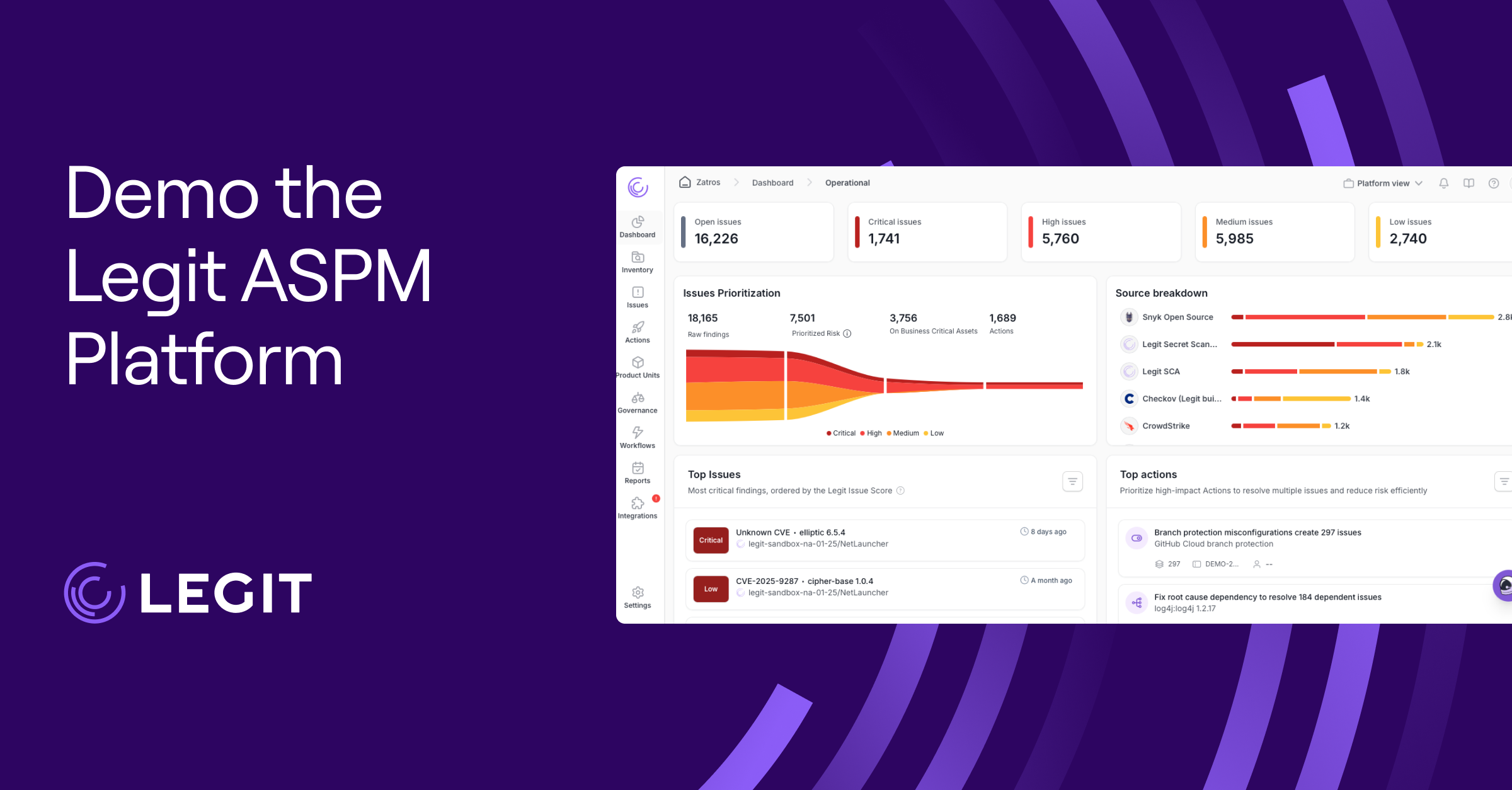Get guidance on key tenets of the EU CRA and how Legit can help address them.
Modern software development moves at high velocity — often with complex toolchains and distributed teams. Against this backdrop, the EU Cyber Resilience Act (CRA) has emerged to ensure that organizations shipping products with digital elements embed security from the ground up. For CISOs, security leaders, and compliance officers, it’s more than a legal checkbox: it’s an opportunity to elevate your organization’s risk posture and protect core business value.
Below is a concise look at how to approach some of the key requirements of the EU CRA, and how Legit Security’s Application Security Posture Management (ASPM) platform aligns with these mandates.
Ensuring an Appropriate Level of Cybersecurity
CRA mandates that organizations adopt a risk-based approach to cybersecurity. This means not only understanding the types of technologies and vulnerabilities/weaknesses you have in your organization, but whether those technologies are, for example, Internet facing, touching sensitive data, or interacting with different AI engines. Only once you have complete visibility of the attack surface can you really start to understand the complete scope of risk within your application portfolio and make actionable inferences into it.
Legit Security addresses this by continuously discovering and analyzing your entire SDLC — from code to cloud — and everything in between. This visibility allows you to understand the real risk of a particular application or vulnerability by taking the entirety of the application and business context into consideration. Further, all of this context and risk-based prioritization can be used to create very granular and specific policies or guardrails based on business criticality, sensitive data usage/exposure, or other relevant data points. This allows organizations to prioritize fixes or processes where multiple risks overlay and potentially deprioritize risk that isn’t reachable, exploitable, or part of a business-critical system.
Eliminating Known Exploitable Vulnerabilities
No organization wants to ship software with critical weaknesses or vulnerabilities, but often the speed at which products are being made, changed, and shipped makes this an inevitability. However, Annex I within the CRA adds a new requirement for any software or digital products being sold by organizations into the EU to “be made available on the market without known exploitable vulnerabilities.” With organizations often having thousands of vulnerabilities, this can become a very tall order without the right context and visibility into all the important details of a weakness or vulnerability.
Legit Security helps in a few different ways here. First, part of the context Legit offers is exploitability likelihood through several different means including EPSS and CISA KEV to name a couple. Additionally, our code-to-cloud visibility lets us know whether a vulnerability is Internet exposed and can even be reached by an attacker from outside the organization or product.
Taking this a step further, our policy engine allows you to create rules that block or guardrail against any new known exploitable vulnerability being added to your product as development continues at the breakneck pace with shifts like AI and vibe coding.
Control Mapping and Protection Against Unauthorized Access
One of the hardest CRA areas for organizations to get a handle on is knowing and proving where appropriate controls and configurations are in place vs. where they’re lacking. This lack of visibility often leads to underutilized licenses, unchecked areas of product development, and the potential for unauthorized access into sensitive areas of the development environment. One of the ways security-conscious organizations are combating this is through the creation of “paved pathways” that include very specific technology and security tooling to be utilized across all their development environments, but this often requires extreme vigilance of deviations within those environments and very few ways to automate the adherence to those standards.
Legit Security not only automatically inventories and details what and where controls exist within an SDLC so you can ensure 100% coverage of your application portfolio, but we also analyze all of the configurations throughout the entirety of the build process to find any that could allow for supply chain attacks or unauthorized access to SCMs or CI/CD systems. This ensures that your teams are using secure defaults and putting appropriate guardrails into development workflows. This also automates baseline enforcement, configuration management, and quick resets to a known safe state when needed.
Highlighting and Documenting Inventory and Attack Surfaces
CRA regulators will fully expect thorough documentation of vulnerabilities, technology, and components within your software supply chain. This includes things like the packages used in an application, where AI or LLMs are being leveraged, or even how things like sensitive data or API endpoints are being exposed within an application.
Legit Security not only automatically generates Software Bill of Materials (SBOMs) and continuously monitors for vulnerabilities at the component level, but it also provides a comprehensive, real-time inventory of all the technologies being utilized across your application portfolio. This includes things like external services, APIs, data models, AI/LLMs, collaborators, containers, and so much more. This visibility allows you to not only keep track of the entirety of your attack surfaces, but also layer context over your vulnerabilities so your team can address issues swiftly and demonstrate compliance with ease.
Addressing and Remediating Vulnerabilities
Once a vulnerability is discovered, the CRA requires prompt action and updates. This ends up being more complicated for massive organizations than just sending the vulnerability to a developer to fix. You need to understand who the appropriate or responsible team/developer is, what the best remediation path is, and all the context behind the vulnerability to make sure it needs to be fixed and won’t potentially break something else once fixed.
Legit Security’s automated workflows employ AI-based risk scoring to prioritize fixes based on actual business context, reachability, and many other important factors, ensuring the most critical problems are tackled first. With a complete understanding of who’s responsible for code changes or owns the project or repository, you ensure that remediation workflows are always going to the right team or person that can fix the issue fast. Additionally, granular and contextual rule-based policies allow you to elevate and prioritize remediation for compound issues that exacerbate the individual risks, i.e., SQL injection on an API that handles sensitive data in an Internet-facing, highly critical business application. Finally, real-time notifications and streamlined update mechanisms in the environments your team lives in (JIRA, ServiceNow, Slack, etc.) keep your teams on the same page without delaying daily operations.
What Are Practical Steps Businesses Can Take to Prepare for the CRA?
Map your products and supply chain
Identify which products fall under the CRA’s scope and map out suppliers, distributors, and importers to ensure clarity on roles.
Implement secure development and maintenance processes
- Set up secure coding practices, vulnerability management, and patching procedures.
- Incorporate a “security by design” approach as early as possible.
Establish and document a product cybersecurity risk management policy
- Conduct thorough risk assessments.
- Ensure these documents can demonstrate compliance to regulators or notified bodies.
Create a coordinated vulnerability disclosure program
Develop a clear policy that enables security researchers and others to report potential issues, and plan for how you’ll communicate vulnerabilities to customers and relevant authorities.
Plan for compliance assessments
For higher-risk products, begin preparing for third-party audits or conformity assessment procedures. Set aside resources and timelines for these reviews.
Stay aligned with evolving EU cybersecurity frameworks
The CRA interacts with other EU regulations (e.g., the NIS2 Directive and the Radio Equipment Directive). Maintaining broader cybersecurity compliance practices will position you to meet future demands.
Conclusion: Turning Compliance Into Competitive Advantage
Complying with the EU Cyber Resilience Act isn’t just about meeting obligations — it’s about championing security best practices internally and throughout your supply chain to better protect your business and customers. By embedding security into every phase of development, proactively documenting vulnerabilities, understanding which of those vulnerabilities are of vital importance, and having all the context needed to remediate them quickly, organizations can transform compliance requirements into strategic assets.
Ready to streamline your path to EU CRA compliance? Legit Security’s ASPM platform provides a unified view of your security posture, integrates seamlessly into existing toolchains, and delivers the automation and AI-driven insights you need to stay ahead of threats. It’s more than just meeting regulations; it’s securing the future of your software delivery.
If you have any specific questions about the EU CRA or how Legit Security’s capabilities can fit into your existing security program, feel free to let me know. Your feedback and input will help us tailor the most effective strategies and solutions for your organization.
Learn more about Legit's compliance capabilities here.
Download our new whitepaper.


